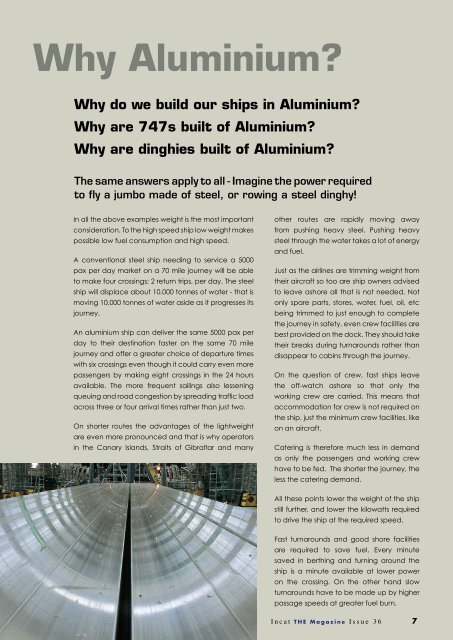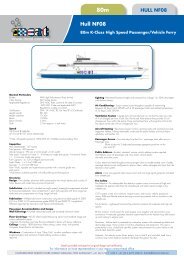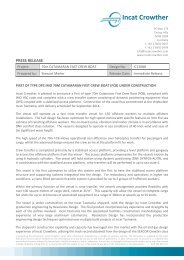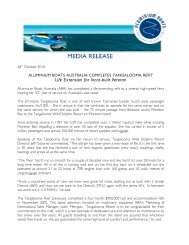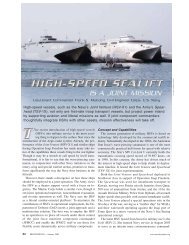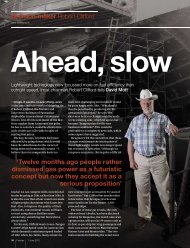US NAVY'S - Incat
US NAVY'S - Incat
US NAVY'S - Incat
You also want an ePaper? Increase the reach of your titles
YUMPU automatically turns print PDFs into web optimized ePapers that Google loves.
Why Aluminium<br />
Why do we build our ships in Aluminium<br />
Why are 747s built of Aluminium<br />
Why are dinghies built of Aluminium<br />
The same answers apply to all - Imagine the power required<br />
to fly a jumbo made of steel, or rowing a steel dinghy!<br />
In all the above examples weight is the most important<br />
consideration. To the high speed ship low weight makes<br />
possible low fuel consumption and high speed.<br />
A conventional steel ship needing to service a 5000<br />
pax per day market on a 70 mile journey will be able<br />
to make four crossings; 2 return trips, per day. The steel<br />
ship will displace about 10,000 tonnes of water - that is<br />
moving 10,000 tonnes of water aside as it progresses its<br />
journey.<br />
An aluminium ship can deliver the same 5000 pax per<br />
day to their destination faster on the same 70 mile<br />
journey and offer a greater choice of departure times<br />
with six crossings even though it could carry even more<br />
passengers by making eight crossings in the 24 hours<br />
available. The more frequent sailings also lessening<br />
queuing and road congestion by spreading traffic load<br />
across three or four arrival times rather than just two.<br />
On shorter routes the advantages of the lightweight<br />
are even more pronounced and that is why operators<br />
in the Canary Islands, Straits of Gibraltar and many<br />
other routes are rapidly moving away<br />
from pushing heavy steel. Pushing heavy<br />
steel through the water takes a lot of energy<br />
and fuel.<br />
Just as the airlines are trimming weight from<br />
their aircraft so too are ship owners advised<br />
to leave ashore all that is not needed. Not<br />
only spare parts, stores, water, fuel, oil, etc<br />
being trimmed to just enough to complete<br />
the journey in safety, even crew facilities are<br />
best provided on the dock. They should take<br />
their breaks during turnarounds rather than<br />
disappear to cabins through the journey.<br />
On the question of crew, fast ships leave<br />
the off-watch ashore so that only the<br />
working crew are carried. This means that<br />
accommodation for crew is not required on<br />
the ship, just the minimum crew facilities, like<br />
on an aircraft.<br />
Catering is therefore much less in demand<br />
as only the passengers and working crew<br />
have to be fed. The shorter the journey, the<br />
less the catering demand.<br />
All these points lower the weight of the ship<br />
still further, and lower the kilowatts required<br />
to drive the ship at the required speed.<br />
Fast turnarounds and good shore facilities<br />
are required to save fuel. Every minute<br />
saved in berthing and turning around the<br />
ship is a minute available at lower power<br />
on the crossing. On the other hand slow<br />
turnarounds have to be made up by higher<br />
passage speeds at greater fuel burn.<br />
<strong>Incat</strong> THE Magazine Issue 36 7


